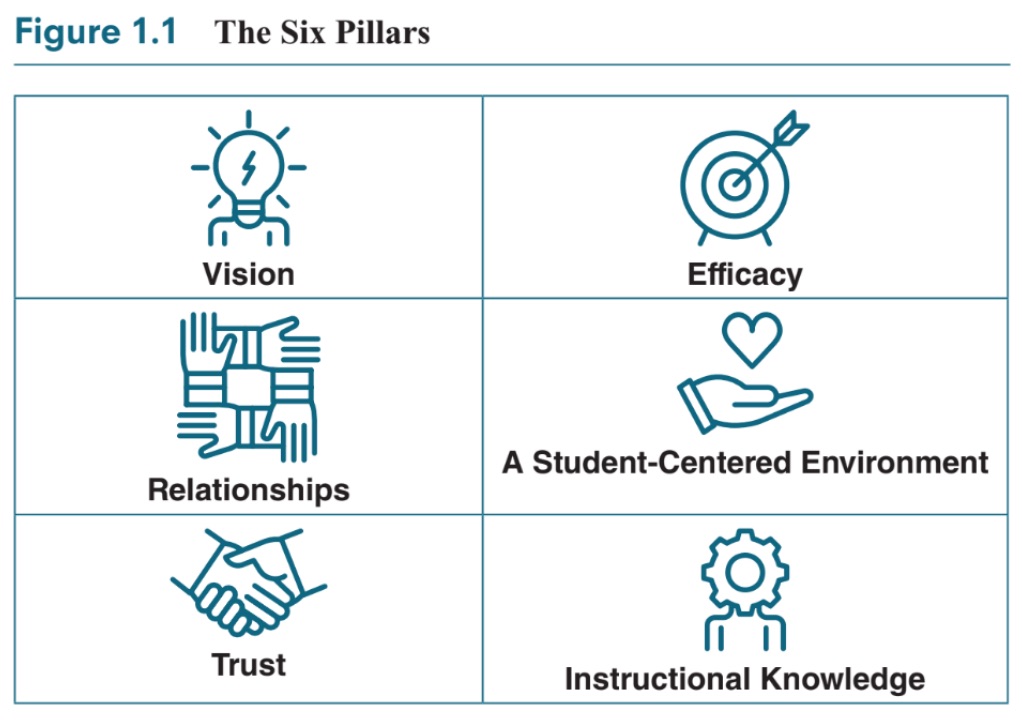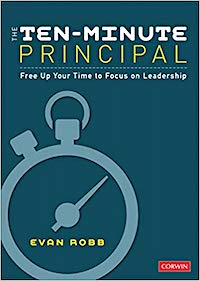Use 6 Leadership Pillars to Empower Teachers
 By Evan Robb
By Evan Robb
“If your actions inspire others to dream more, learn more, do more and become more, you are a leader.” – John Quincy Adams
When I was a young principal, the quote by John Quincy Adams would not have resonated with me as it does today.
I became principal of a junior high school I opened in Warren County, Virginia when I was thirty. The summer before my position became official, ordering school furniture, sports equipment, and band instruments was my focus. Sharing leadership was not on my radar that year.
Two years later I began reading books by leaders like Jim Collins and Warren G. Bennis. They influenced my leadership style from being the leader who worked closely with staff to becoming a leader among leaders.
So yes, I am fond of this quote by John Quincy Adams. It defines the inspirational role of the principal. Traditionally, the principal is often called “the instructional leader,” but instructional leadership should not be about one person. When principals encourage teachers to “become more,” they change the traditional concept of teacher.
My challenge to principal colleagues
I’m challenging principals to consider developing teachers’ leadership capacity. I believe schools and principals benefit from teacher leadership in really powerful ways. For this to occur, teachers need to be encouraged, empowered, and offered opportunities to lead. In my book, The Ten-Minute Principal, I urge principals to free up time to focus on leadership – and share a construct to help administrators and teachers increase their leadership capacity:.
“The Six Pillars of Leadership” form the foundation needed to develop creative and innovative school cultures. Whether you’re a principal or teacher, it’s helpful to reflect on each pillar and how you might integrate it into every aspect of school life. The principal can empower teachers to support instructional leadership through mentoring and coaching colleagues, by leading professional learning workshops and organizing professional book and article studies.

✻ How might I use the pillars to initiate impactful change?
The First Pillar: Vision
What dreams do administrators have for teaching and learning at their school? Taking time to discuss the future can inspire principals and teachers to work diligently for positive changes. Discussions of the future help shape priorities – where leaders put their time, what they value, and how they communicate those values!
The key to creating vision is that it must be collective and not a top-down decision. A personal vision is where the leader may want to go; a collective vision is where leaders and the group want to go. For example, with the help of students, teachers can create a vision statement for learning in their classrooms; principals collaborate with staff and teachers to gather input for developing a vision for the entire school.
Reflect on: How do your decisions, teachers’ decisions, and the school community’s decisions align with the school’s vision?
The Second Pillar: Relationships
Effective teachers and principals have the skills needed to establish positive relationships. No formula exists for creating positive relationships. However, there are some common elements that effective relationship builders have: they care, communicate, build trust, develop empathy, and have a sincere interest in others.
There is much truth in this old saying: students won’t care what we know until they know we care. Leadership doesn’t work without establishing relationships. Remember that it’s the principal who sets the tone in his or her school. Trusting, positive relationships contribute to a positive tone, and that’s why they must be worked on with diligence all the time.
Reflect on: How do relationships affect others? How are you cultivating positive relationships?
The Third Pillar: Trust
Just like relationships, building and extending trust must be daily practice for principals and teachers. Trust can take a long time to be established and is the building block of positive relationships. Effective principals and teachers foster trusting relationships by making collaborative decisions that can lead to embracing creative thinking and innovation.
Staff and students need to know the direction or vision of their school and to experience relationships that build trust and value their ideas. Since trust and safety walk hand in hand, the result can be staff, teachers, and students who are more willing to take intentional risks to improve and grow or to let go of what’s holding them back.
Reflect on: What are you doing to enhance trust? How do you model relationship building?
The Fourth Pillar: Efficacy
The belief that leaders can make a significant difference for a child separates the intentions and motivations between poor and exceptional teachers and administrators. To spread efficacy among a school community and foster collective efficacy, the first three pillars must be firmly in place.
Collective efficacy means that an entire school works to improve teaching and learning, so every child’s needs are met and every child progresses. Collective efficacy creates a school culture that values ongoing learning as well as a congruency among words, actions, and beliefs. The more teaching, learning, communication, and collaborative skills school members have, the stronger personal and collective efficacy becomes.
Reflect on: What are you doing to enhance your skills and the skills of your staff? What are teachers doing to nurture and cultivate students’ skills as well as their own?
The Fifth Pillar: A Student-Centered Environment
The idea that one program or method of teaching can meet the needs of all students doesn’t work, and here’s why. Students arrive at school with diverse experiences and background knowledge in math, reading, critical thinking, vocabulary development, problem solving, and social skills. In a student-centered environment, teachers and administrators recognize and accept these differences and make decisions that are in the best interests of all students.
To develop a student-centered approach to learning, teachers need the flexibility to refine and adjust learning experiences so every student improves and grows. For this approach to flourish, ongoing building-level professional learning becomes an important part of a school’s culture.
Learning with colleagues and having conversations about teaching increases teachers’ knowledge and understanding of a student-centered approach. All the while, teachers build their bank of ways to organize instruction so students have choices and input.
When approaching decision making in a student-centered environment, it’s important for principals and teachers to reflect on these questions:
✻ Will my decisions support students’ learning?
✻ Has instruction been adjusted to meet the needs of learners?
✻ What can be done when students are not learning?
✻ How can we enhance learning opportunities for students and find ways for them to demonstrate understanding?
✻ How can professional learning meet the varied needs of teachers?
The Sixth Pillar: Instructional Knowledge
Staying current and being a learner, an educator committed to growth and increasing his or her knowledge base enhances the profession and benefits students. Instructional knowledge impacts each of the pillars. Lack of instructional knowledge will inhibit directly or indirectly collaborating to build a vision, relationships, trust, and efficacy, or creating a student-centered school.
When educators embrace a personal and professional responsibility to be learners, they develop the knowledge to grow and in turn can help staff and students learn. Today there are many ways to use social media to develop a Personal Learning Network (PLN), The choice to continually learn and grow rests with individuals, but the principal can inspire staff by becoming a self-motivated learner and sharing his or her enthusiasm and knowledge. Notice and note with an email or personal conversation teachers who are active on social media with the goal of learning about teaching from others.
Reflect on: How can you encourage staff to be self-motivated learners?
The Six Pillars: Leadership Guideposts
The pillars work in concert to form a solid and lasting foundation for principal and teacher leadership. They are guideposts and enable you to develop a positive school culture that values taking risks, showing kindness, building relationships, raising questions, collaborating, and communicating.

When the principal encourages teacher agency and provides and honors leadership opportunities, a school becomes stronger. Seek out ways to share leadership by empowering teachers to use their efficacy and the six pillars to positively impact students and colleagues. At the same time, use leadership to create a positive culture so students and staff can thrive and succeed.

His book The Ten-Minute Principal: Free Up Your Time to Focus on Leadership was published by Corwin in May 2019. His latest book, Aiming High: Leadership Actions to Increase Learning Gains, is also from Corwin (2022).
Evan and author-consultant Laura Robb (his mom) collaborated with Dave Burgess Publishing to write TeamMakers (2019). Evan has also partnered with Laura to write Schools Full of Readers with Benchmark Education. Connect with Evan on X-Twitter @ERobbPrincipal. Learn more at Evan Robb.org.




































This is quite impressive. Thank you for sharing your wisdom with teachers like us. It is inspiring and motivating. All principals should have this vision
Thanks, I’ve learned a lot from this platform. As a newly appointed principal I would like to be mentored. Thanks again
Thanks for sharing this valuable information. I would like to be mentored. I really need this.
Inspirational words indeed
Thanks for sharing. Very good information and I learned a lot from this article’s
Appreciate for your sharing, it’s very informative for my students.